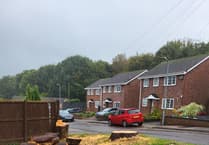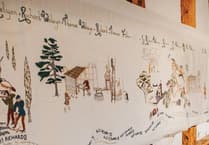STUART Wilson first came across the ‘Lost City of Trellech’ when he was first invited to look at the field across the road to investigate a possible house in a field. The local man spoke to Monmouthshire Beacon about the thought process which drove him to dig up lost treasures.
Archaeology is all about discovering something new according to Stuart who says it’s different from reading books.
“It's like having an iPhone back in the Victorian period,” added Stuart.
“Someone's rubbish could be someone's gold mine.”
The archaeologist lived with his parents and spent his life savings on a field to pursue what he always loved. After spending £32,000 on a 4.6-acre field in a village in Monmouthshire he began the dig.
Stuart believed his findings proved who had either visited or lived in the area. He talked about finding a medieval flowerpot found in the courtyard of the Manor House. At the time it would have been extremely rare to come across one as they were typically made from leather.
Coins were also discovered on the site which originated from Scotland and Limerick meaning people were either travelling to or from those places, suggesting Trellech would have been very active at the time.
One of the most exciting finds on the dig is the suspect of Royalty passing through.
“We do know Edward III was hunting in Trellech for a long time in 1348, he would go hunting and stay in people's manor houses,” he said.
“It is speculated that he did stay in the manor house on the site where there was a fireplace. This was very unusual at the time as most manor houses don't typically get a fireplace, only a few castles and abbeys would have one.”
Stuart confirms one of the main reasons archeology is important is because it preserves people’s reputations and he feels very fortunate to embrace an area so rich in history.
“I live in a converted toilet block. It would have been easier if I had earned more money beforehand then did the dig.”
“But compared to some other people I am extremely lucky.”
After finding such an exciting, uncovered city, Stuart states if he hadn’t of found ‘The Lost City of Trellech’ he would've liked to dig up a city found in North Africa because it’s dry, warm and its next to the coast where you can go swimming.
He believes less than 0.1 per cent of the entire settlement has been uncovered. They thought it was about one per cent a few years ago but the more they find, the more they realise the scale of the ancient settlement.
At one point they thought the town extended just to the Trellech cross, a mile in length from the Church in the village on the north end, but now they are using a 200 year old map and comparing it to the current field boundaries, as seen on Google Earth it is clear the town extended from three miles in length.
After working in the archeology sector for many years Stuart has attained many skills and lessons along the way.
“You have to be careful when digging and even the smallest piece of evidence may hold significant clues. I know I have likely missed finding some evidence because of my own lack of knowledge.
An example of this was when they were digging in the buttery and pantry of the manor house. Luckily by having a stone mason they were able to identify what looked like pieces of broken stone from the room which revealed it had a stone ceiling with lime washing.
Stuart believes that incoming technology would have really helped them understand more than what was possible at the time when they started 24 years ago.
“A good example is AI that has been used on some sites around the world to scan the location of every bit of rubble, then using their location and angle of fall to fully reconstruct the building.”
“Landscape archaeology helped identify the site, logic indicated the rough location as houses are often located along a road, and the road exists. Finally, metal probes were used to detect a wall below ground through the vibrations that were caused allowing us to pinpoint the correct location to excavate and make the discovery on the first occasion.”
Investing a lot of his time to uncover a mystery, Stuart said: “If I had not made the discoveries that I made I would not know what I didn’t at first.
“Many years of my life since I have personally experienced it. I try to visualise what Trellech would have looked like but just looking at some of the weird and wonderful house designs of medieval buildings that still exist, it is unlikely we would ever reconstruct their designs from their footprints. I know I can only guess at the basic outline and the individual interesting details which probably elude us.
With many years of experience Stuart shared some advice to other aspiring archaeologists.
“Be prepared to travel around and have a strong stomach, as you will find many interesting finds but never have the time or money to properly investigate. Seeing them destroyed can be heart breaking. Commercial archaeology can pay well but is competitive and is mostly contractual and often you need to be flexible.
“You will be on site with a single trowel covering developments where multiple mechanical diggers are working. The sad fact of life is you will never have enough time to save everything, so do the best you can.
“It is a very interesting job. Every day the next major discovery could be found by you.”




Comments
This article has no comments yet. Be the first to leave a comment.